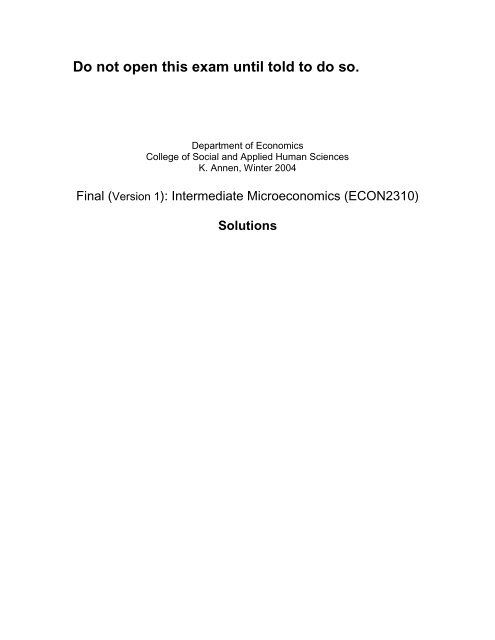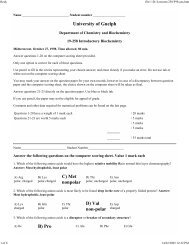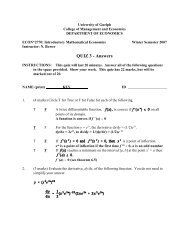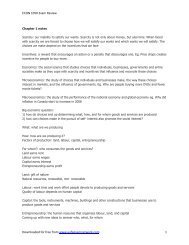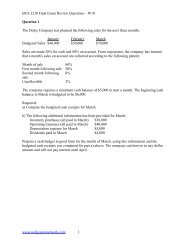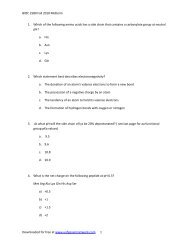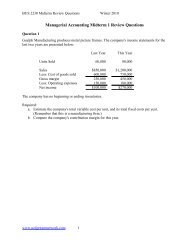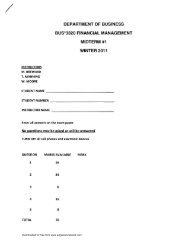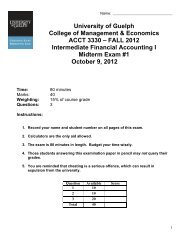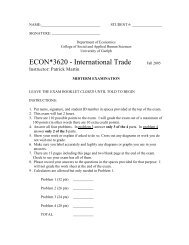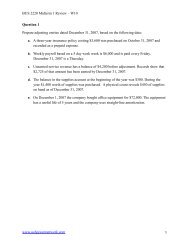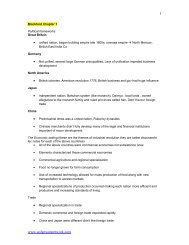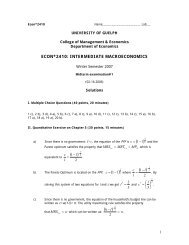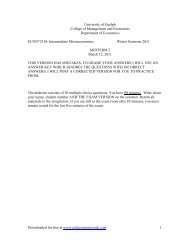Budget Set - University of Guelph Exam Network
Budget Set - University of Guelph Exam Network
Budget Set - University of Guelph Exam Network
Create successful ePaper yourself
Turn your PDF publications into a flip-book with our unique Google optimized e-Paper software.
Do not open this exam until told to do so.Department <strong>of</strong> EconomicsCollege <strong>of</strong> Social and Applied Human SciencesK. Annen, Winter 2004Final (Version 1): Intermediate Microeconomics (ECON2310)Solutions
Final (Version 1) ECON2310/Winter2004/Annen 2PART 1: Monopoly and Monopoly Behavior1) In a market with a monopolist who is maintaining second-degree pricediscrimination the consumer surplus is necessarily zero.a) True.b) False. (2 points)2) If he produces anything at all, a pr<strong>of</strong>it-maximizing monopolist with some fixedcosts and no variable costs will set price and output so as to maximizerevenue.a) Trueb) False (2 points)3) If a supplier has a monopoly in a market, the outcome is necessarilyinefficient.a) Trueb) False (2 points)4) A market is characterized by imperfect competition if firms are “price takers”.a) True.b) False. (2 points)25) A monopolist with the cost function c ( q)= 20 + q faces the inverse demandcurve p = 180 − 4q. Calculate the output and the price that maximize themonopolist’s pr<strong>of</strong>it. Calculate the monopolist’s pr<strong>of</strong>it.Calculation: MC=2q; MR=180-8q; 2q=180-8q; 10q=180; q=18; p=108Pr<strong>of</strong>it=R-C=18*108-20-18^2=1600Final Answer: qm= _18__ pm= __108 πm= __1600_ (3 points)6) Consider the monopolist in 5) and assume that this monopolist behavesperfectly competitive. Calculate the output and the price that maximize themonopolist’s pr<strong>of</strong>it, and calculate its pr<strong>of</strong>it under this assumption.Calculation: MC=2q MR=180-4q; 2q=180-4q; 6q=180; q=30; p=60Pr<strong>of</strong>it=R-C=30*60-20-30^2=880Final Answer: qc= _30__ pc= __60___ πc= _880____ (3 points)7) Consider the monopolist in 5) and 6). Calculate the deadweight loss in thismarket that is due to the fact that this monopolist has market power.Calculation:(12*24)/2+(12*48)/2=432Final Answer: Deadweight Loss=___432____(4 points)8) Bulk-discount is an example <strong>of</strong> second-degree price discrimination.a) True.b) False. (2 points)
Final (Version 1) ECON2310/Winter2004/Annen 39) A monopolist has decreasing average costs as output increases. If themonopolist sets price equal to average cost, it will produce too much outputfrom the standpoint <strong>of</strong> efficiency.a) Trueb) False (2 points)10) Isabel has just written an interesting new book. Her publisher estimates thatthe demand for her book among students will be D S( p)= 500 − 20p, and thedemand among other people will be D o( p)= 300 − 20 p . The publisher has acost function <strong>of</strong> c( q)= 10 + 4q. Calculate the output and price that maximizethe publisher’s pr<strong>of</strong>it if the publisher has to charge the same price forstudents and other people. Calculation:Total Demand = 800-40p; Inverse demand: p=20-1/40 q; MC=4; MR=20-1/20q; 4=20-1/20 q; 16=1/20 q; q=320; p=12Final Answer: q = _320_____ p = ____12___ (4 points)11) Consider the same situation than in question 10). But assume now that thepublisher can charge a different price for students and other people.Calculate the output and price that maximize the publisher’s pr<strong>of</strong>it in themarket with students and in the market with other people. Calculation:Students: MC=4; MR=25-1/10 q; 4=25-1/10 q=; 210=q; p=25-1/20*210=29/2Other people: MC=4; MR=15-1/10 q; 4=15-1/10 q; 11=1/10 q; q=110; p=15-1/20 110=9.5Final Answer: qS= _210__ pS= __14.5 qo= _110__ po= __9.5_(4 points)12) A firm has discovered a new kind <strong>of</strong> nonfattening, nonhabitforming dessertcalled zwiffle. It doesn't taste very good, but some people like it and it can beproduced from old newspapers at zero marginal cost. Before any zwifflecould be produced, the firm would have to spend a fixed cost <strong>of</strong> $ F . Demandfor zwiffle is given by the equation q = 12 − p . The firm has a patent onzwiffle, so it can have a monopoly in this market.a) The firm will produce zwiffle only if F is less than or equal to 36.b) The firm will not produce zwiffle if F > 12 .c) The firm will produce 12 units <strong>of</strong> zwiffle.d) The firm will produce 9 units <strong>of</strong> zwiffle.e) None <strong>of</strong> the above. (4 points)13) A monopolist that produces a positive amount <strong>of</strong> output maximizes pr<strong>of</strong>itswhere marginal revenue equals marginal cost.a) Trueb) False (2 points)
Final (Version 1) ECON2310/Winter2004/Annen 4PART 2: Oligopoly14) A Stackelberg leader will necessarily make at least as much pr<strong>of</strong>it as hewould if he acted as a Cournot oligopolist.a) True.b) False. (2 points)15) The monopoly outcome in a given market generates a higher total industryoutput than the Stackelberg outcome in this market.a) Trueb) False (2 points)16) The reaction function <strong>of</strong> firm 1 measures pr<strong>of</strong>its for any given level <strong>of</strong> output<strong>of</strong> firm 1 and output <strong>of</strong> firm 2.a) Trueb) False (2 points)17) There are two major producers <strong>of</strong> corncob pipes in the world, both located inHerman, Missouri. Suppose that the inverse demand function for corncobpipes is described by 120 − 6( q1+ q2) , where q1and q2is firm 1’s and firm 2’soutput respectively. Marginal costs are MC = 2 for both firms. CalculateCournot equilibrium in this market. Calculation:Reaction function firm 1: MC=2; R=120q1-6q1^2-6q1*q2; MR=120-12 q1-6q2. 2=120-12 q1 – 6 q2; q1=59/6-1/2 q2.In equilibrium, q1=q2=q since firms are symmetric.q=59/6 -1/2 q; 1.5 q=59/6; q=6.556Final Answer: q1= _6.556 q2= ___6.556 (4 points)18) Consider again the market in exercise 17). Calculate the Stackelbergoutcome assuming that firm 1 can move first and firm 2 second.Calculation:Reaction function firm 2: q2=59/6-1/2q1; MR <strong>of</strong> firm 1: R=120 q1 – 6 q1^2 –6 q1 (59/6 -1/2 q1); MR=120 – 12 q1 – 59 + 6 q1; 61-6 q1; 2=61 – 6 q1; q1 =59/6=9.833; q2=59/6-29.5/6=4.92Final Answer: q1= _9.833 q2= _4.92__ (4 points)19) The situation in which firms in an oligopoly compete with respect to prices iscalled Bertrand competition.a) Trueb) False (2 points)PART 3: Game Theory20) A two-person game in which each person has access to only two possiblestrategies will have at most one Nash equilibrium.a) Trueb) False (2 points)
Final (Version 1) ECON2310/Winter2004/Annen 521) A general has the two possible pure strategies, sending all <strong>of</strong> his troops byland or sending all <strong>of</strong> his troops by sea. An example <strong>of</strong> a mixed strategy iswhere he sends 1/4 <strong>of</strong> his troops by land and 3/4 <strong>of</strong> his troops by sea.a) Trueb) False (2 points)22) Consider the static game as described by the following pay<strong>of</strong>f matrix.(i)(ii)(iii)L RT -1,2 11,1B -3,5 10,10The Row player has a dominant strategy.a) Trueb) FalseThe Column player has a dominant strategy.a) Trueb) FalseFind all pure strategy Nash equilibria in this game.Final Answer: ____(T,L)________________________________(6 points)23) A dominant strategy equilibrium is a set <strong>of</strong> choices such that each player'schoices are optimal regardless <strong>of</strong> what the other players choose.a) Trueb) False (2 points)24) Consider a revised version <strong>of</strong> the game “Rock, Paper, Scissors”. In thisrevised version each <strong>of</strong> the two players has a forth option which is called“Dynamite”. The rule is that Dynamite beats Rock, Paper, and Scissors.Assume that the winner gets a pay<strong>of</strong>f <strong>of</strong> 1; looser gets a pay<strong>of</strong>f <strong>of</strong> -1; and incase <strong>of</strong> a tie, both get 0.(i) Analyze this situation as a game and write down the pay<strong>of</strong>f matrix.Rock Paper Sci DyRock 0,0 -1,1 1,-1 -1,1Paper 1,-1 0,0 -1,1 -1,1Sci -1,1 1,-1 0,0 -1,1Dyn 1,-1 1,-1 1,-1 0,0(ii)(iii)Indicate whether the Row and/or the Column player have a dominantstrategy. If yes, what is the dominant strategy?Final answer:_Dyn is a dominant strategy for both players.Compute all pure Nash equilibria in this game:Final answer:_________(Dyn, Dyn)____________________(6 points)
Final (Version 1) ECON2310/Winter2004/Annen 625) The Prisoner’s dilemma has one dominant strategy equilibrium.a) Trueb) False (2 points)PART 4: Asymmetric Information26) The fact that an insurance company must be concerned about the possibilitythat someone will buy fire insurance on a building and then set fire to it is anexample <strong>of</strong> adverse selection.a) Trueb) False (2 points)27) A firm hires two kinds <strong>of</strong> workers, alphas and betas. The population at largehas equal number <strong>of</strong> alphas and betas. One can't tell a beta from an alpha bylooking at her, but an alpha will produce $3,000 worth <strong>of</strong> output per monthand a beta will produce $2,500 worth <strong>of</strong> output in a month. The firm decidesto distinguish alphas from betas by having workers take an examination. Aworker will be paid $3,000 if she gets at least 60 answers right and $2,500otherwise. For each question that they get right on the exam, alphas have tospend 1/2 hour studying and betas have to spend 1 hour. For either type, anhour's studying is as bad as giving up $10 <strong>of</strong> income per month. This schemeleads toa) a separating equilibrium where alphas score 60 and betas score 0.b) a pooling equilibrium where alphas score 60 and betas score 0.c) a pooling equilibrium where everybody scores 60.d) a pooling equilibrium where everybody scores 0.e) a separating equilibrium where everybody scores 60. (4 points)28) In a market where there is signaling, a separating equilibrium occurs wheneconomic agents separate their actions as consumers from their actions asproducers.a) Trueb) False (2 points)29) In <strong>Guelph</strong>, Ontario, there are many used cars for sale; the fraction 1 − q <strong>of</strong>these cars are good and the fraction q <strong>of</strong> them are lemons. Owners <strong>of</strong>lemons are willing to sell them for $100. Owners <strong>of</strong> good used cars arewilling to sell them for prices above $1,500 but will keep them if the price islower than $1,500. There is a large number <strong>of</strong> potential buyers who is willingto pay $400 for a lemon and $2,500 for a good car. Buyers can't tell goodcars from bad, but original owners know.(i.) What is the price <strong>of</strong> a used car if q = 0. 5 (Assume that sellers get thewhole exchange surplus). Calculation: 200+1250 < 1500; owners <strong>of</strong>good cars won’t sell.Final Answer: p = __$400____.(ii.) What is the price <strong>of</strong> a used car if q = 0. 1 (Assume that sellers get thewhole exchange surplus). Calculation: $40+ $2250=2290>1500;owners <strong>of</strong> good cars will sell.Final Answer: p = _2290___. (4 points)
Final (Version 1) ECON2310/Winter2004/Annen 730) An example <strong>of</strong> adverse selection is the situation where someone chooses acar that is not as good as it is claimed to be.a) Trueb) False (2 points)PART 5: Externalities31) If your consumption <strong>of</strong> toothpaste produces positive externalities for yourneighbors (which you ignore), then you are consuming less toothpaste thanis Pareto optimal.a) Trueb) False (2 points)32) A noisy production plant disturbing a pr<strong>of</strong>essor when writing a researchpaper with pr<strong>of</strong>ound insights is an example <strong>of</strong> a consumption externality.a) Trueb) False (2 points)33) A trade between two people is an example <strong>of</strong> an externality.a) Trueb) False (2 points)34) Suppose that in Halifax the cost <strong>of</strong> operating a lobster boat is $4,000 permonth. Suppose that if x lobster boats operate in the bay, the total monthly2revenue from lobster boats in the bay is 1000(12x − x ) .(i)If there are no restrictions on entry and new boats come into the bayuntil there is no pr<strong>of</strong>it to be made by a new entrant, then how manyboats will enter?Calculation: 1000 (12-x)=4000; 12-x = 4; x=8(ii)Final answer: x = _____8______ (3 points)If the number <strong>of</strong> boats that operate in the bay is regulated to maximizetotal pr<strong>of</strong>its, then how many boats will enter?Calculation: 1000 (12 – 2x) = 4000; x=4Final answer: x = ____4_______ (3 points)PART 6: Extra-Point Question35) Find the mixed strategy Nash equilibrium in the static game described by thepay<strong>of</strong>f matrix below.L RT 1,0 0,1B 0,2 2,0Final Answer: _____(r=2/3, c=2/3) where r= prob <strong>of</strong> playing T and c= prob<strong>of</strong> playing L._________________________(4 points)


